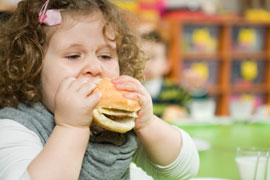How Much is Too Much?

Obesity in children is an ongoing concern today. There are many contributors to this, but the main reasons include too much food and calories, and not enough activity or exercise. This creates an imbalance where energy input exceeds energy output, even in a growing child. Excess calories are stored as fat, resulting in overweight or obese children. Poor food choices (ie processed foods high in salt, fat and calories) and less activity due to more screen time (TV, computers and electronic devices) are responsible for this energy imbalance.
But how do parents know if they are over-feeding their kids? First, it is important to make sure you are offering kids healthy meals and snacks that are well-timed throughout the day. Generally, young children should be eating every few hours (about 3 meals and 2 snacks daily). Try to ensure that snacks do not fall too close to meal times or else kids may not be hungry for dinner.
Consider portion size—an appropriate serving size for a young child is half to a whole small apple or banana, ½ cup of berries, 1 cup or less of milk, ¼ cup of crackers, dry cereal, unsalted nuts or 1 to 2 small cookies. Limit the amount of snacks that provide little nutritional value such as foods that are highly processed with lots of added sugar, salt and empty calories. Something to remember—hunger may actually be mistaken for thirst—offer water as a thirst quencher versus sugary beverages or juices. Water and milk are recommended as beverages of choice for younger and older children.
Next, don’t force your kids to eat. Forcing a child to finish their plate rather than listening to their own hunger and fullness cues can create a pattern of over-eating. If children have been offered healthy meals and snacks in age-appropriate portion sizes, then we need to listen as parents when they say they have had enough to eat. Better to offer small quantities of food and let them ask for seconds if they wish.
Growth is always the best indication for whether or not your child is getting too much or not enough. Ask your doctor at the next appointment to see your child’s growth chart and ensure that your child is growing at an appropriate rate.
In terms of exercise and activity, the Canadian Society for Exercise Physiology recently released new guidelines for the amount of activity kids should get every day. They suggest a minimum of 60 minutes of moderate to vigorous activity daily. Examples include biking, skating, running and rollerblading.
Healthy eating with appropriate portion sizes, and daily activity and exercise should be a family affair.













